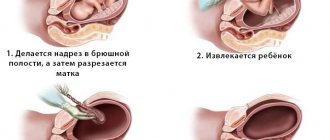Anesthetics
In modern anesthesiology, various medicinal substances are used to relieve labor pain. Premedication is carried out during the preparation process. Premedication includes the prescription of sedatives, analgesics, anticholinergics and other drugs. The use of these drugs is aimed at weakening the negative impact of emotional stress on the body, preventing possible side effects associated with anesthesia, facilitating anesthesia (it is possible to reduce the concentration or dose of the drug used, the excitation phase is less pronounced, etc.) Anesthesia is carried out using various medications . Medicines can be administered intramuscularly, intravenously or inhalation. All anesthetics act primarily on the central nervous system. Drugs acting on the central nervous system include: analgesics, tranquilizers, narcotic analgesics, etc. The proposed list of drugs is far from complete, but in my opinion it gives an idea of the drugs and their effects. Propanidide (sombrevin, epantol; a means for intravenous anesthesia) - when administered intravenously, it quickly binds to plasma proteins, quickly decomposes into inactive metabolites, and is not detected in the blood 25 minutes after administration. The narcotic effect occurs immediately after the administration of sombrevin, after 20-40 seconds. The surgical stage of anesthesia lasts 3-5 minutes. Propanidide causes a more pronounced hypnotic effect than an analgesic one. Sombrevin penetrates the placental barrier, but after 15 minutes it decomposes into inactive components. There is evidence that sombrevin can lead to respiratory depression, acidosis in the fetus, and cause allergic reactions in the mother. Ketamine hydrochloride (calypsol, ketalar; analgesic) - half-life is about 2 hours. After intravenous administration, the narcotic effect occurs within 30 seconds and lasts 10 minutes; after intramuscular injection - after 5 minutes and lasts 15 minutes. It has a strong analgesic effect, does not relax skeletal muscles and does not inhibit reflexes from the respiratory tract. In pregnant women, it increases the tone of the uterus. Ketamine penetrates the placental barrier and in doses of more than 1.2 mg/kg of the mother's body weight causes depression of the vital functions of the fetus. There is evidence that sombrevin and ketalar also have an effect on the body’s immunological system. Thus, when administered sombrevin, the number of T- and B-lymphocytes decreases by 15 and 4%, while when administered ketalar, they increase by 10 and 6%, respectively, which suggests that ketalar is less dangerous in pregnant women with allergic diseases. diseases, blood loss and immune system deficiency. This is important, since during pregnancy there is a shift in the immune system of the mother’s body, which consists in a decrease in cellular and humoral immunity, in addition, a number of immunological systems are directly related to perinatal damage to the central nervous system of the fetus. Barbiturates (sodium thiopental, hexenal; drugs for non-inhalation anesthesia) - after intravenous administration, 65-70% of the dose of barbiturates binds to plasma proteins, and the remaining free fraction has a narcotic effect. The narcotic effect of barbiturates is based on inhibition of the cerebral cortex and blockade of synapses. Barbiturates are weak acids, having a low molecular weight, penetrate the placental barrier, and the degree of depression in the fetus is directly proportional to the concentration of the anesthetic in the mother's blood. Diazepam (Relanium, Seduxen; tranquilizers) - sedatives that relieve irritability, nervousness, and stress. When administered orally, it is absorbed in an amount of about 75%, the maximum level in plasma occurs after 1-1.5 hours. In the liver, 98-99% of diazepam is metabolized into the enterohepatic circulation. The half-life in the blood plasma of women is 1-3 days, in newborns - 30 hours. In the fetal blood, the highest concentration is created 5 minutes after intravenous administration. In the blood of the umbilical cord of a newborn, the concentration of diazepam is equal to its concentration in the venous blood of the mother when administered in a dose exceeding 10 mg or more. At the same time, the concentration of diazepam in the brain is low. In this case, apnea in newborns, hypotension, hypothermia, and sometimes signs of neurological depression are common. Diazepam is able to accelerate the dilation of the cervix and helps relieve anxiety in a number of women in labor. Promedol (narcotic analgesic) is easily absorbed by any route of administration. The maximum concentration in plasma is determined after 1-2 hours. The mechanism of action of promedol is based on interaction with opiate receptors. It has an analgesic, sedative effect, and depresses the respiratory center. After parenteral administration, the analgesic effect occurs within 10 minutes and lasts 2-4 hours. Promedol has an antispasmodic effect and promotes dilatation of the cervix. Easily penetrates the placenta. 2 minutes after intravenous and somewhat later after intramuscular administration, a concentration appears in the umbilical cord blood approximately equal to that in the maternal blood plasma, but there may be significant fluctuations in individual fetuses depending on their intrauterine state. The more time passes from the moment of administration of the drug, the higher its concentration in the blood of the newborn. The maximum concentration of promedol and its toxic metabolite in the blood plasma of a newborn was observed 2-3 hours after its administration to the mother. The half-life of promedol elimination from the body of a newborn is approximately 23 hours, and in the mother - 3 hours. Promedol is generally considered safe for mother and baby. However, in some cases, the drug can cause depression in the newborn due to the fact that it has an inhibitory effect on the processes of glycolysis and the respiratory center. Promedol, like all morphine-like drugs, has a number of disadvantages, the main of which is that in effective doses (more than 40 mg) it depresses breathing and causes severe drug dependence, can cause a state of stupor, nausea, vomiting, smooth muscle atony, constipation, depression, low blood pressure. Promedol can cause respiratory depression and drowsiness in a child. After birth, breathing is restored, but children do not immediately latch onto the breast. The described side effects are inherent in almost all potent analgesics, with the exception of pentazocine (Lexir, Fortral). For pain relief, non-narcotic analgesics (baralgin, analgin...) are usually not used, since they inhibit labor. Promedol (a narcotic analgesic) is used in most Moscow clinics as a pain reliever. Promedol has an analgesic and antispasmodic effect (helps accelerate the opening of the pharynx). An injection of promedol is administered into the buttock or thigh. Promedol manifests itself in different ways. For some, it has a calming effect, relaxes, and causes drowsiness, although consciousness is completely preserved. For someone else, some women lose control of themselves, experience a state of intoxication, and may feel nauseous and stagger. Pentazocine (Lexir, Fortral; narcotic analgesic) - indicated for pain relief during labor. It has a stimulating effect on hemodynamics and respiration, and also has a birth-stimulating effect. Does not have a pronounced sedative effect. This drug is considered to be non-narcotic, incapable of causing addiction, that is, an analgesic without a psychometic effect. Diprivan (propofol) is a new ultra-short-acting intravenous anesthetic. Diprivan quickly induces sleep, maintains the inclusion of consciousness throughout the infusion (infusion) of the drug with a rapid restoration of consciousness after stopping the infusion, and has fewer side effects compared to other intravenous anesthetics. However, a number of publications indicate possible undesirable manifestations of diprivan during anesthesia, including a deterioration of certain parameters of central hemodynamics, although data on this issue are extremely contradictory. From a pharmacological point of view, diprivan is not an anesthetic, but a hypnotic. Nitrous oxide (a means for inhalation anesthesia) is one of the components of general anesthesia for caesarean section. The drug is insoluble in lipids. It is absorbed very quickly (2-3 minutes) and excreted unchanged by the lungs. 5-10 minutes after the start of inhalation, tissue saturation with anesthetic reaches its maximum. In 5-6 minutes it is completely eliminated from the blood. A relatively weak anesthetic with a high degree of safety when mixed with oxygen. It affects only the central nervous system, does not depress respiration, the cardiovascular system, and does not have a negative effect on the liver, kidneys, metabolism, or contractile activity of the uterus. It quickly penetrates the placenta, after 2-19 minutes the concentration of nitrous oxide in the blood of the umbilical cord vein is 80% of the level in the mother's blood. Long-term inhalation of nitrous oxide sometimes results in the birth of a baby with low Apgar scores. Nitrous oxide is given through a special apparatus using a mask. The woman in labor is introduced to the technique of using nitrous oxide; in the future, she puts on a mask herself and inhales nitrous oxide with oxygen during contractions. During pauses between contractions, the mask is removed. Nitrous oxide mixed with oxygen significantly reduces pain without completely eliminating it and causes euphoria. It is used at the end of the first stage of labor. The effect of the gas appears after half a minute, so at the beginning of the contraction you need to take several deep breaths. The gas dulls the pain; when inhaling it, the woman feels dizzy or nauseous. Nitrous oxide is usually given in combination with narcotic analgesics. Relaxants (ditilin, listenol, myorelaxin; muscle relaxants) - are slowly and incompletely absorbed in the digestive tract. Do not penetrate the placenta. Causes persistent muscle relaxation. These relaxants do not affect the condition of the newborn, but in some newborns with impaired feto-placental permeability, some authors note a low Apgar score. The use of drugs for the treatment of pain and anxiety in women in labor involves the use of anesthetics and analgesics, both narcotic and non-narcotic, and their combination with sedatives and neuroleptics.
Medical indications for pain relief for women in labor
The possibility of using anesthesia during childbirth is due to the following indications:
- Arterial hypertension in a woman in labor;
- A sharp increase in a woman’s blood pressure during labor;
- Preeclampsia;
- Pathologies in the work of the cardiovascular system of a woman in labor;
- Respiratory diseases;
- Diabetes;
- Decreased cervical tone;
- Decreased labor activity;
- Pain intolerance in women;
- Psycho-emotional stress;
- Large fruit;
- Incorrect position of the baby in the uterus;
- The age of the woman giving birth is too young.
There are few contraindications for labor anesthesia, but they exist and every woman who is preparing to give birth to a child needs to know them.
The use of anesthesia is strictly prohibited in such cases as:
- Poor blood clotting of the mother in labor;
- Severe neurotic syndrome of the expectant mother;
- The presence of internal bleeding in a woman;
- The presence of inflammatory processes at the site of analgesic administration.
Neuroleptanalgesia method
The method of neuroleptanalgesia, which provides a kind of mental peace, satisfactory analgesia, accompanied by stabilization of hemodynamic parameters and the absence of a significant effect on the nature of labor, has become quite widespread for pain relief. Fentanyl is injected intramuscularly. The greatest effect is achieved when combined with droperidol. If necessary, a repeat dose is administered after 3 to 4 hours. Neuroleptanalgesia is not recommended for use if the patient has severe hypertension (high blood pressure) or increased bronchiole tone. You need to be prepared for the possibility of drug-induced depression in the newborn. Narcotic analgesics have a depressive effect on the respiratory function of the newborn.
Ataralgesia method
Another common method of labor pain relief. The ataralgesia method is a combination of analgesics with diazepam, seduxen and other benzodiazepam derivatives. Benzodiazepane derivatives are among the safest tranquilizers; their combination with analgesics is especially indicated for severe fear, anxiety and mental stress. The combination of dipyridole with seduxen has a beneficial effect on the course of labor, shortening the total duration and period of cervical dilatation. However, there is an effect on the condition of the newborn, in the form of lethargy, low Apgar scores, and low neuroreflex activity.
Pain relief during childbirth - all types of anesthesia for expectant mothers
Pain relief during childbirth helps a woman more easily cope with the birth of her baby. Advances in anesthetic techniques are minimizing the risk of complications. Let's take a closer look at the methods of anesthesia during childbirth, find out which types are preferable, and how to relieve pain during childbirth without drugs.
Epidural analgesia method
This method has been studied quite thoroughly. The beneficial effect of epidural analgesia during pregnancy and childbirth, complicated by gestosis, nephropathy, late toxicosis, in the anesthesia of labor in the breech presentation of the fetus is important; it has a beneficial effect on the course of premature birth, reducing the period of cervical dilatation and lengthening the period of expulsion, which contributes to a smoother advancement of the head. At the same time, under the influence of epidural analgesia, the muscles of the perineum relax and the pressure on the fetal head decreases. It is indicated for congenital and acquired heart defects, chronic diseases of the lungs and kidneys, edema, myopia (myopia) and damage to the retina. At the same time, epidural analgesia may cause a decrease in uterine activity. There was also an increase in the duration of labor and a decrease in uterine activity in the second stage of labor during epidural analgesia, which contributed to an increase in the number of surgical deliveries (forceps, Caesarean section). A negative hemodynamic effect is also known. In addition, hypotension of the bladder and increased temperature (hyperthermia) are noted. Various drugs are currently used for epidural analgesia (local anesthetics, narcotic and non-narcotic analgesics, diazepam, ketamine). Lidocaine is the most widely used drug in pregnant women. Lidocaine is metabolized in the liver. Cumulation (accumulation) of the drug often occurs, which subsequently manifests itself as neuro- and cardiotoxicity in relation to the mother and fetus. Epidural analgesia provides long-lasting and highly effective pain relief from the onset of labor until birth, but can cause serious complications. The principle of epidural analgesia in labor is that the anesthetic is injected into the epidural space and blocks the subdural nerves in the T10 to L1 segments. It is effective when contractions cause severe back pain and position changes do not help or are difficult. Its time should be calculated so that the effect of the anesthetic ceases by the second stage of labor, otherwise labor may slow down and the risk of episiotomy and forceps may increase. Anesthesia should be stopped when pushing begins. This period requires “personal” participation from the woman. Anesthesia is not stopped in the second stage of labor (pushing period), if there are special indications for this, for example, myopia.
What causes pain during childbirth?
During the first stage of labor, contractions of the uterus (contractions) and dilation of the cervix cause excessive irritation of the nerve endings, which in turn send a signal interpreted by the brain as pain. In addition, the vessels and muscles are stretched, and the intensity of their blood supply decreases, which can also increase the severity of pain.
In the second period, the main factor contributing to the occurrence of pain is the pressure of the presenting part of the fetus on the lower part of the uterus, and its movement through the birth canal.
In response to increasing pain, the brain generates a response from the body - increased heart rate and breathing, increased blood pressure, and excessive emotional arousal.
It is worth noting that in many ways the intensity of pain during childbirth depends not only on the level of the woman’s pain threshold, but also on her psycho-emotional state. Stress, fear, anticipation of pain, and a negative attitude increase the amount of adrenaline produced, resulting in increased perception of pain. Conversely, calmness and balance promote the production of endorphins (hormones of joy), which naturally block the perception of pain.
Standard technique for epidural analgesia in labor
In obstetric practice, combined subdural-epidural anesthesia and analgesia are used. The epidural space is punctured with an epidural needle, through which a needle is then inserted to puncture the subdural space. After removal of the subdural needle, the epidural space is catheterized. The main application of the method is the administration of narcotic analgesics for effective pain relief from contractions, followed by the use of continuous infusion epidural analgesia from the end of the first stage of labor. An epidural takes about 20 minutes to administer. The woman is asked to curl up with her knees touching her chin. The puncture is performed in a lateral or sitting position. Many anesthesiologists use a sitting position for puncture, since in this position it is easier to identify the midline of the back, which often causes certain difficulties due to swelling of the subcutaneous tissue of the lumbar region and sacrum. The back is treated with an anesthetic solution. After local anesthesia, the skin is pierced with a thick needle to facilitate subsequent needle insertion for epidural analgesia. The epidural needle is slowly advanced into the interspinous ligament (the doctor inserts a hollow needle into the intervertebral disc). A syringe is attached to it. The anesthesiologist injects an anesthetic with a syringe into the lower back. The medicine is delivered through a tube inside the needle as needed. The needle is not removed, which allows you to administer an additional dose if necessary. The effect of the anesthetic wears off after 2 hours. It may be accompanied by some difficulty in movement and trembling in the hands. Some women feel weakness and headache, as well as heaviness in the legs, which sometimes lasts for several hours, skin itching, and urinary retention. Like all methods of pain relief, such anesthesia has a number of side effects and complications. Epidural anesthesia with concentrated solutions of local anesthetics can increase the duration of the first and second stages of labor, and then there is a need for oxytocin (oxytocin increases uterine contractility) or surgical delivery. Side effects such as respiratory depression, lower back pain, temporary numbness of the limbs, headache, dizziness, nausea, vomiting, itching, and depression may occur. You should immediately report any unpleasant sensations to your doctor! The most dangerous complication is inflammation of the peridural space, which can appear on days 7-8. This happens when the rules of asepsis and antiseptics are poorly followed. Another complication is hypotension (low blood pressure). It occurs as a result of an overdose of the drug; to prevent this from happening, the woman in labor is given medications that increase vascular tone. A competent and highly qualified doctor, understanding the seriousness of the entire procedure, will explain to the woman all the pros and cons and will not perform epidural anesthesia unless absolutely necessary, simply because he was asked. Most anesthesiologists discuss with women the effectiveness and benefits of this method for both mother and baby and the risk of possible complications. After which the woman signs papers stating that she is familiar with all the pros and cons and agrees to this procedure. (“It is a natural sense of self-protection for the anesthesiologist to want written consent; the obstetrician should note in her notes that the woman consents to the epidural, and the anesthesiologist would be wise to simply sign the note.”) Take your time during a normal pregnancy and during normally developing labor, do an epidural. It’s a different matter when this is the only way to relieve pain during childbirth and carry it out safely. Then try, after talking with your doctor, to be as favorable as possible about this procedure! A positive attitude is 90% of success! In the process of choosing, you can doubt, think about, weigh, choose what is best for you now, BUT, when you have made a decision, follow only it! Vanity and tossing around in the mind will only ruin things. Women who are subsequently dissatisfied with epidural analgesia during labor usually come to the maternity hospital with a strong attitude towards this method of pain relief and agree to it only when there is no time for detailed explanations. You should adhere to the tactic of “explain, but do not persuade. This means that, while explaining to a woman all the advantages of spinal methods of pain relief, one should not insist on their choice. This is due to the fact that when analyzing complications, it often turns out retrospectively that most of the troubles occur in those women who categorically refused epidural anesthesia or analgesia, but succumbed to the doctor’s persuasion. Apparently, there is something more serious than our ideas about the clinical physiology of spinal methods of pain relief. Of course, the ideal time to discuss the role of spinal pain management with expectant parents is before birth.”










